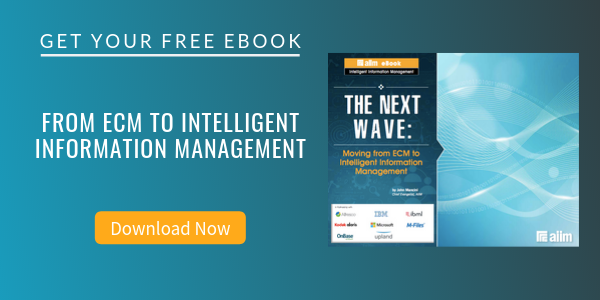
The 3 Disrupters That Are Driving the Era of InfoChaos
Intelligent Information Management (IIM)
 In my previous post -- Welcome to the Era of InfoChaos: How Will Your Organization Adjust? -- I discussed the colliding forces of Information Opportunity and Information Chaos. In this post, I want to discuss how we wound up in this strange place of incredible opportunity and risk.
In my previous post -- Welcome to the Era of InfoChaos: How Will Your Organization Adjust? -- I discussed the colliding forces of Information Opportunity and Information Chaos. In this post, I want to discuss how we wound up in this strange place of incredible opportunity and risk.
I believe there are three major disruptors that are simultaneously colliding to transform the world as we know it.
- Consumerization - transforming what users expect from applications.
- Mobile and Cloud - leading to an expectation of anywhere, anytime access.
- Changing Nature of Work - forcing organizations to think flat and agile, not hierarchical and slow.
Managing the InfoChaos created by the volume, variety, and velocity of information and content from these disrupters is THE business challenge of the next decade. Let’s take a moment to think about why each of these is so disruptive to how we manage information.
Consumerization
We are in an era of massive decentralization of technology resources and a massive increase in the talent available to utilize those resources. In Digital Disruption: Unleashing the Next Wave of Innovation, Forrester’s James McQuivey looks at the four major factors necessary for massive disruption:
- “A computer? Check.
- An internet connection? Check.
- A programming language and SDK? Check.
- A friction-free platform for distributing and making money…? Check.”
What this means is that how we look at applications in the enterprise, how we buy enterprise technology, and how we deploy enterprise systems are all changing simultaneously. There are more sources of innovation available in more places in the world than ever before, and the era in which organizations could exclusively depend on their internal IT resources as a source of competitive advantage is at an end.
It wasn’t that long ago that complex enterprise systems were the exclusive domain of a limited number of vendors who delivered complex and expensive solutions to a relatively limited number of primarily large customers. That’s all changed. SaaS companies like Salesforce.com, Workday.com, Marketo.com, and Basecamp.com have totally revolutionized the market for enterprise-scale solutions.
The assumption that many business people now have is that solutions can be delivered as seamlessly and as simply as consumer-based solutions are delivered in our private lives. This isn’t fair -- and it certainly isn’t this simple – but that is the assumption. As organizations increasingly confront information management challenges that begin with paper and end somewhere in the cloud, the potential for increasing Information Chaos intensifies.
Mobile and Cloud
Cloud and mobile are the two great technology steroids. They change everything. They change our expectations of where we can work, when we can work, with whom we can work, and on what devices we can work.
According to Portio Research (March 2013), 1.2 billion people worldwide were using mobile apps at the end of 2012. This is forecast to grow at a rate of 29.8 percent each year to reach 4.4 billion users by the end of 2017. Much of this growth will come from Asia, which will account for almost half of app users in 2017.
There has also been a revolution in the platforms we use to host content and processes. According to ABI Research (March 2013), 56 billion smartphone apps will be downloaded in 2013. By operating system: 58 percent will be Google Android; 33 percent Apple iOS; 4 percent Microsoft Windows Phone; 3 percent BlackBerry.
This can’t help but influence how we ultimately think about Enterprise applications. Gartner (April 2013) predicts that by 2017, 25 percent of enterprises will have an enterprise app store. They also note, "Apps downloaded from public app stores for mobile devices disrupt IT security, application, and procurement strategies. Bring your own application (BYOA) has become as important as bring your own device (BYOD) in the development of a comprehensive mobile strategy.”
A new generation of knowledge workers brings radically different perceptions of how individual employees connect with enterprise systems. Per the CISCO 2012 Connected World Technology Report, “For the “always-connected” generation, a single mobile device will do, whether it is a personal device or a company-owned device, which creates challenges for the IT managers who must safeguard company assets and information.” Two out of five workers under age 30 say their company’s policy forbids them to use company-issued devices for non-work activities; however, nearly three out of four (71 percent) say they don’t always obey those policies. Organizational policy has not yet caught up operational reality. In 50% of organizations, employees are encouraged to use social tools in relation to their job, but in half of these – 26% -- no guidelines are given for how they should accomplish this.
Cloud technologies work in a constantly reinforcing loop with mobile technologies to disrupt the way we traditionally think about information management.
There is a tendency to think about the cloud purely in terms of cost savings. However, as Forbes’ Joe McKendrick points out, “IT cost savings and speedier deployment are but a brief prelude to the main story. It’s only the first 10 percent. The remaining 90 percent is what happens to the business itself. It’s the transformation, enabling it to react to market opportunities, communicate and collaborate internally and externally, design and test new products, and become more agile. This ‘second chapter’ to cloud will produce far greater, but far more intangible, benefits.”
According to Geoffrey Moore, “SaaS frees us all from the tyranny of the product release business model. Yes, with SaaS, there is some level of ongoing disruption that you must cope with both within IT and with your user base, but please, do not even mention that in the same breath with the kind of burden the product release model imposes. Instead, thank your lucky stars you are getting innovation that you are paying for when you are paying for it. It is current, and so are you. This is huge!”
The challenge, of course, in all of this is that mobile and cloud technologies increase the volume, variety, and velocity of information in our organizations – and heighten Information Chaos in the short term.
Changing Nature of Work
According to the BusinessDictionary.com, a flat organization is one “in which most middle-management levels and their functions have been eliminated, thus bringing the top management in direct contact with the frontline salespeople, shop floor employees, and customers.”
The flattening of hierarchies is accelerated by consumerization and cloud and mobile technologies. In Throwing Sheep in the Boardroom: How Online Social Networking Will Transform Your Life, Work and World, Matthew Fraser and Soumitra Dutta, two professors at INSEAD, talk about how corporations are evolving from a traditional pyramid set-up to a much flatter network one. “Network organizations are generally characterized by informal trust networks,” the authors write. Their employees are “intrinsically motivated based on personal satisfaction…The advantage of network organizations is their adaptiveness and capacity to innovate when faced with change and uncertainty. . . . Network organizations, needless to say, are the habitat of Web 2.0 social media.” (quoted from Forbes, 2/2/2011).
Per Jason Fried, co-founder of 37signals, a Chicago-based software firm, and co-author of the book Rework: “We're not big fans of what I consider "vertical" ambition—that is, the usual career-path trajectory, in which a newbie moves up the ladder from associate to manager to vice president over a number of years of service. On the other hand, we revere "horizontal" ambition—in which employees who love what they do are encouraged to dig deeper, expand their knowledge, and become better at it. We always try to hire people who yearn to be master craftspeople, that is, designers who want to be great designers, not managers of designers; developers who want to master the art of programming, not management.”
While social technologies by themselves will not disrupt rigid hierarchies (organizational culture, after all, is the trump card), they can be a rapid accelerator for organizations committed to becoming flatter and more agile. This raises levels of Information Chaos as older and more rigid information workflows are disrupted, without a clear picture of what will take their place.
About John Mancini
John Mancini is the President of Content Results, LLC and the Past President of AIIM. He is a well-known author, speaker, and advisor on information management, digital transformation and intelligent automation. John is a frequent keynote speaker and author of more than 30 eBooks on a variety of topics. He can be found on Twitter, LinkedIn and Facebook as jmancini77. Recent keynote topics include: The Stairway to Digital Transformation Navigating Disruptive Waters — 4 Things You Need to Know to Build Your Digital Transformation Strategy Getting Ahead of the Digital Transformation Curve Viewing Information Management Through a New Lens Digital Disruption: 6 Strategies to Avoid Being “Blockbustered” Specialties: Keynote speaker and writer on AI, RPA, intelligent Information Management, Intelligent Automation and Digital Transformation. Consensus-building with Boards to create strategic focus, action, and accountability. Extensive public speaking and public relations work Conversant and experienced in major technology issues and trends. Expert on inbound and content marketing, particularly in an association environment and on the Hubspot platform. John is a Phi Beta Kappa graduate of the College of William and Mary, and holds an M.A. in Public Policy from the Woodrow Wilson School at Princeton University.



